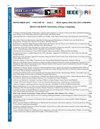Radio Coverage Analysis of a 4G Network in Ambato's Center
IF 1.3
4区 工程技术
Q3 COMPUTER SCIENCE, INFORMATION SYSTEMS
引用次数: 0
Abstract
This study presents a radio coverage analysis of the 4G LTE network operated by Ecuadors National Telecommunications Corporation (CNT) in Ambatos Historic Center, a dense urban area with complex topography. Over a seven day period, field measurements of the Reference Signal Received Power (RSRP) were collected along 13 primary and 19 secondary streets using two mobile devices on mid-range and one low equipped with the Network Cell Info Lite application. Both pedestrian and vehicular scenarios were evaluated, and compliance with the regulatory parameter SMA-QoS-9, established by Ecuadors Telecommunications Regulation and Control Agency (ARCOTEL), was assessed based on minimum power ( 100 dBm) and location coverage ( 95%). Results revealed that measured coverage fell below the regulatory threshold, with average compliance levels of 84.71% for pedestrian data and 76.77% for vehicular data, while simulated results based on official base station parameters reached 100% coverage. A 2.43 dB discrepancy in RSRP was observed between pedestrian and vehicular measurements, attributed to Doppler effects, signal obstruction, and multipath propagation. The proposed low-cost and accessible methodology is shown to be effective for in assessing real-world LTE performance, enabling operators and regulators to identify critical coverage gaps and calibrate network simulators. These findings support service improvement strategies and provide a foundation for efficient 5G NR deployment in similar urban environments.安巴托中心4G网络无线电覆盖分析
本研究对厄瓜多尔国家电信公司(CNT)在Ambatos历史中心运营的4G LTE网络进行了无线电覆盖分析,这是一个地形复杂的密集城区。在7天的时间里,使用配备Network Cell Info Lite应用程序的两台中低端移动设备,沿着13条主要街道和19条次要街道收集了参考信号接收功率(RSRP)的现场测量数据。对行人和车辆场景进行了评估,并根据最小功率(100 dBm)和位置覆盖(95%)评估了厄瓜多尔电信监管和控制机构(ARCOTEL)制定的监管参数SMA-QoS-9的合规性。结果表明,实测覆盖率低于监管阈值,行人数据的平均符合率为84.71%,车辆数据的平均符合率为76.77%,而基于官方基站参数的模拟结果覆盖率为100%。由于多普勒效应、信号阻塞和多径传播,行人和车辆的RSRP测量值存在2.43 dB的差异。所提出的低成本和易于使用的方法被证明是评估实际LTE性能的有效方法,使运营商和监管机构能够识别关键的覆盖差距并校准网络模拟器。这些发现为服务改进策略提供了支持,并为在类似城市环境中高效部署5G NR提供了基础。
本文章由计算机程序翻译,如有差异,请以英文原文为准。
求助全文
约1分钟内获得全文
求助全文
来源期刊

IEEE Latin America Transactions
COMPUTER SCIENCE, INFORMATION SYSTEMS-ENGINEERING, ELECTRICAL & ELECTRONIC
CiteScore
3.50
自引率
7.70%
发文量
192
审稿时长
3-8 weeks
期刊介绍:
IEEE Latin America Transactions (IEEE LATAM) is an interdisciplinary journal focused on the dissemination of original and quality research papers / review articles in Spanish and Portuguese of emerging topics in three main areas: Computing, Electric Energy and Electronics. Some of the sub-areas of the journal are, but not limited to: Automatic control, communications, instrumentation, artificial intelligence, power and industrial electronics, fault diagnosis and detection, transportation electrification, internet of things, electrical machines, circuits and systems, biomedicine and biomedical / haptic applications, secure communications, robotics, sensors and actuators, computer networks, smart grids, among others.
 求助内容:
求助内容: 应助结果提醒方式:
应助结果提醒方式:


